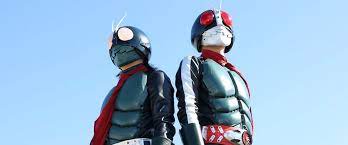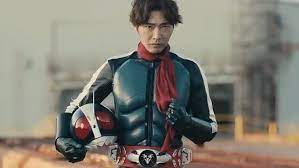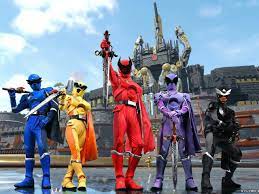(SPOILER WARNING!!)
Let me make this clear right off the bat;
Yes, I am fully aware that this film was produced by Shinichiro Shirakura, the exec at Toei whose work I straight-up refuse to watch either in my own time or for the sake of review. It is a vow that, following my rewatch of Kamen Rider Drive as well as first (and only) viewing of Super Hero Taisen Grand Prix, I swore I would uphold for as long as he continues to produce his garbage.
HOWEVER, I was hearing from people that he, in an out of character move, kept himself relatively hands free from the project and allowed director/writer Hideaki Anno to have full creative control of the film. Maybe Shirakura was too busy producing Zenkaiger and Donbrothers back-to-back to get more involved, or maybe he knew not to interfere with Anno while he creates; either way, I was more than happy to know that he was as far from this film's production as possible and couldn't get his greedy, controlling fingerprints all over it.
As for my history with Hideaki Anno, it pretty much begins and ends with Shin Gojira, which I did a review on back in 2017 (don't read it, the review was awful). Since my review, I have gone back and rewatched the film; and overall, I have come to appreciate what it did a lot more in retrospect, both as a love letter to the franchise as well as a social commentary on the inefficiency of bureaucracy and red tape during a time of disaster. It certainly is a film that has gotten better with repeated viewings, which is a blessing as the Legendary films have only gotten worse on rewatch.
With that said, I am fully aware of Anno's love of old-school Tokusatsu, in particular the Ultra series (which, for the record, still need to watch an Ultra series before deciding if I like it) which he has referenced a LOT in his anime series Neon Genesis Evangelion (which I've never watched). He even got attention due to creating the parody fan film Return Of Ultraman, which is what would lead to him meeting friend and future collaborator Shinji Higuchi to eventually direct Shin Ultraman. Anno clearly has a lot of love and reverence for Toku as a whole, which made him the perfect choice for creating these new films for the three main pillars of the medium (or is Toku a genre? I'm not sure); Godzilla for Toho, Ultraman for TsuPro, and Kamen Rider for Toei.
Just a pity that Toei were still being jackasses regarding international distribution and unceremoniously shoved the film on Amazon Prime Video in the UK while America got two theatrical releases in select theatres.
Oh, wait; Shirakura's in charge of overseas distribution now. That explains it.
Plot:
As a remake of the original series with story elements from the manga being integrated in, the story is going to be very familiar. Athlete and grade-A university student Takeshi Hongo is kidnapped by the organisation SHOCKER (which is now an acronym for Sustainable Happiness Organisation with Computational Knowledge Embedded Remodelling) to become a cyborg and slave for their plans for subjugating the world under the guise of "pursuing happiness for all of mankind". However, Hongo is rescued from the organisation by his university professor Hiroshi Midorikawa, as well as his artificially created daughter Ruriko, so that he can fight back against SHOCKER and their inner circle of Augments (or Augs) before they can accomplish their plans. Thus, following Hiroshi's death at the hands of Kumo Aug and in spite of the fear of his newfound powers brought on by the energy source known as "prana", Hongo adopts the mantle of Kamen Rider and stands against SHOCKER for humanities freedom.
Pros:
One thing that I must praise straight away; Anno NAILED the aesthetic of the original series, and that is probably best reflected in the suit designs for the Riders. He doesn't try to simply give the suits a streamlined update that only vaguely captures the look of the original suits (looking at you, Kamen Rider The First/The Next); he just does the suits again, but with more detail. Even small stuff like the hair sticking out the back of the helmet or the mouthpiece being slightly off-centre; it all feels like it jumped out of the classic series into the modern era without being out of place. This even extends to the way that fights are shot and choreographed, having a lot of chaotic and frantic editing while still being coherent enough to follow.
The first 25 minutes of this film are arguably the greatest sign of love and respect that Anno has for the original show, with how it's basically a high-budget recreation of the first episode from 1971. It isn't just the basic story beats, either; he goes so far as to do shot-for-shot updates of a lot of the classic scenes. The shot of Hongo standing on the hill in his suit (complete with the bushes being painstakingly remade with CGI), Hongo transforming on the bike, his first fight with the Combatmen and Kumo Aug, him appearing in front of the car as it arrives at a dam; even the admittedly campier elements like the monsters of SHOCKER all turning to foam upon death are done in as serious a manner as possible without compromising the tone of the film.
With that said, there are still plenty of significant changes that align closely with the depiction of the story from the original manga, but it never feels like they're simply trying to shove a square peg into a round hole; chiefly, the violence. Every time Hongo punches a Combatman, they practically explode into blood puddles, which is what we see happen in the manga during the fights with the monsters. But thanks to the film keeping a relatively down to Earth tone and atmosphere throughout the entirety of the runtime, it never feels like it conflicts with anything or causes the audience to suffer from tonal whiplash. If anything, it helps to emphasise Hongo's innate humanity and compassion whenever he interacts with Ruriko and the two come to help each other grow as individuals.
Speaking of our characters, I really like how they were depicted in this version. Hongo, along with conveying the stoic nature of his original namesake, is shown to be broken and conflicted at several points; not only because of his new status as an Augment, but due to the tragedy he faced in the past of watching his father get stabbed to death during a hostage situation. Hongo is frequently called naive or "weak-willed" by other characters in the film, but his kindness and compassion are still shown to be one of his greatest strengths, which in turn allows this depiction of the character to stand out from the original while still showing respect and homage to the classic hero.
As for Ruriko, they made quite a few changes compared to her 70's counterpart. For one, she is an artificially created human with A.I augmentations made by SHOCKER, as she possesses the ability to "hack" other peoples prana (which, in short, is an omnipresent energy source made from all living things). This not only helps to give Ruriko a larger role in the story beyond the "damsel-in-distress" persona of the original series, but her character is shown to be almost robotic in her actions, to the point where she doesn't mourn her father's death. This, in turn, makes it all the more interesting to see her overcome this part of her character and come to appreciate the sense of happiness that Hongo provided from something as simple as riding on the bike with him. And this, overall, creates a strong bond between the two without having to force them into a romantic relationship. They work off of each very well, and their contrasting personas creates a powerful dynamic that eventually ends in tragedy.
Even Ichimonji Hayato, despite his role being somewhat reduced, gets a lot of personality for the short time he's here; being introduced as the newest Batta-Aug under SHOCKER's control while still retaining his cheerful and borderline playful charm, which helps to contrast him against Hongo when the pair fight each other for the first time before Ruriko frees him from the prana-induced mind control. And much like his 70's counterpart, he gives a lot of "firsts" for his time as a Rider; namely, the first transformation pose and the first (out of two) "Henshin" in the film. They even made sure that, just like the original, his suit is still visually distinctive enough so that he isn't confused with Hongo. Hayato might not have a lot of screen-time, but the time spent with him is certainly enjoyable.
As for SHOCKER themselves, they've also gone through quite the revision for the modern times, but one that still matches up with how they're depicted in the original. Instead of being the shat-out leftovers of the Nazis (and yes, the original Shocker are factual Nazis; just look at Colonel Zol for proof), this version is a straight up cult of psychopaths and sociopaths looking to attain their one true sense of "happiness", which is basically a way for them to use their powers for their own selfish gains. Whilst not having the same fascist connotations of the original Shocker, it has the same devout fanatical following with delusions of being messengers of the gods (the frequent use of the blue butterfly imagery also feeds into this). This actually makes SHOCKER feel more in line with the likes of the Happy Science cult, namely because of their shared supposed goal of "guiding mankind to a state of pure happiness" while their leaders prop themselves up as gods.
Also; their main program being called "I" as a reference to the "eye" of the original Great Leader was actually really damn clever.
Also-also; Robot Detective K is there. He's not evil, he's just an observational robot working for SHOCKER. Although, his predecessor being named "J" is a neat little nod to the behind-the-scenes plans for his original series.
If you know, you know.
Also X3: I loved the reveal of the intelligence agents being Tachibana and Taki this whole time; helps to tie it all together and retain their roles as support for the main characters, especially as they reveal their names to Hayato at the end in what is likely a nod to the pair working mainly with Hayato in the original series.
Cons:
As much as I really enjoy all of the nods to the original show and manga, along with the updates they did to make them work as both a remake and a standalone story, there are still issues that I have that would probably turn people off if they wanted to get into it. Chiefly, a lot of the nods and references only really work if you are already familiar with the original story in either TV or manga form. While I can appreciate those homages as someone who has read the manga and is currently watching the series, I can understand where people are coming from if they feel like it's being exclusionary to them for the sake of appeasing the old school fans. Some of them do feel like nudge-nudge/wink-wink references, like Anno is saying "Look, it's that scene from the original! Isn't that cool?!" This isn't strictly a detriment to the film itself, but I can see it being something that newer fans likely won't resonate with due to their lack of familiarity with the franchise as a whole.
One thing that I feel IS a detriment, however, is the penultimate fight. It's a bike battle with Hongo and Hayato fending off against 11 more Batta Augs (basically this film's version of the Shocker Riders from the original series/manga), which sounds fun on paper. In practise, on the other hand, it doesn't really feel that impressive or important in the grand scheme of things. These Shocker Riders basically come out of nowhere to fight our heroes, and it never really feels exciting at any point due to it being ridiculously hard to see thanks to the lack of proper lighting in the scene. To top that off, it becomes really apparent that this is the scene where they chose to spend most of their CGI budget, as the Shocker Riders (when you can see them) look incredibly fake and lack any kind of weight to them. I want to be excited to see Hongo and Hayato fighting alongside each other for the first time, but as the scene isn't all that important it kind of just passes me by entirely.
And it doesn't help matters that the individual Augs don't really have much in terms of character, or even screen-time. They're pretty much all sadistic psychopaths with their own plans for taking over Japan, and not much else beyond that. Which is ultimately a shame, as I do really love their costume designs. Instead of being literal monsters, they have a similar sleek and armoured aesthetic that the Riders have. This helps to give the designs personality, but also highlights the lack of characterisation that they possess. The most we get is Hachi Aug being an old friend of Ruriko, which does help with Ruriko's own arc of discovering what makes her truly happy in life. But with each of the Augs being disposed off rather quickly (and entirely off-screen in Sasori Augs' case), there isn't really much time for them to shine.
But my biggest critique is one that I've had with modern Kamen Rider for a long time, so it's not a problem with solely this film.
Toei; STOP MAKING YOUR FINAL BOSSES EVIL KAMEN RIDERS!! As soon as I learned that the film's main antagonist, Ichiro Midorikawa, was going to become Kamen Rider No. 0, I actually groaned out loud. I don't know if this is a hot take, but I am sick to death of seeing the main villain of the story become a Kamen Rider. It wasn't interesting when they started doing it, and it certainly isn't interesting now. It honestly feels like a studio decision, as I know that Anno is above doing this with everything he's done so far. Not helped that they tried to give Ichiro a last minute redemption, which I felt missed the mark due to the pacing not really giving him enough to reflect on or regret his actions and the impetus for his redemption (Ruriko's spirit talking him out of it) kind of ignores what the man has done as an executive for SHOCKER.
Conclusion:
In spite of my issues with the villains not getting much time to shine as well as Ichiro's rushed redemption, I still found myself simply loving this movie by its end. It manages to embrace what makes the original an icon in the world of Tokusatsu and Japanese pop culture, while being able to give much of the material an update that still homages the classic series/manga in a positive manner. It is, hands down, the best modern reiteration of Hongo and Hayato's story that we, as fans, have had in literal decades, and I cannot recommend it enough if you are familiar with the source material. It may not be the friendliest for newcomers, but it's still a showcase of why this story is important to the foundations of this franchise and incorporates the best elements that make it great in the first place.
Overall rating: 9 out of 10 (Great).
Thank you so much for reading. I would greatly appreciate it if you can share this on social media (Facebook, Twitter, Instagram, etc) and leave a comment telling me what you thought of the film. Also be sure to follow my social media threads; chiefly, Twitter (my handle is @MediaHood23) and Instagram (again, @mediahood23). And finally, if you want my shitty opinions on Transformers toys, check out my YouTube channel for more; I'm Media Hood Reviews.
But until next time, because their always will be one; this is Callum Lewis, the Media Hood, signing off!








